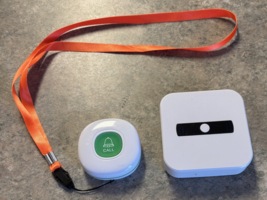¶ Introduction
Reduced mobility and increased care needs necessitate the ability to communicate within the home with minimal effort. Tasks such as signaling for help and answering the door are important and must be easy to do.
¶ Smartphones
Smartphones can be used within home to communicate using voice, video, or text.
Video communication can be useful in circumstances where the disabled individual needs to see a room or area of the house that they are not able to access on their own. The assistant can use their own phone camera to look around on behalf of the other person.
Text communication can be useful when the individual's need is not urgent and can be dealt with when the assistant has a spare moment.
¶ Call Bells
Call bells are a simple and affordable tool for in-home communication. Many call bells are sold with multiple transmitters and receivers. The receivers should be placed in zones where caregivers will be able to hear them easily, while transmitters should be placed within easy reach of the individual that needs them. It is best to have one that is always with the individual themselves, while others can be kept in fixed locations such as the bedside, or near the toilet.

Call bells vary in cost and complexity; some have audible alerts when the batteries are weak, distinct ringtones based on which transmitter button was pressed, and other useful features. These features should be sought when possible.
Call bells should be tested periodically and their batteries replaced every few months.
¶ Outdoor Speakers
Answering the front door of a home can be difficult for an individual with mobility issues. Friends, family, and recurring visitors can be educated about the inability to answer the door, and to simply knock and then let themselves in. Delivery drivers, door-to-door solicitors, and other people, would benefit from the presence of a speaker placed outside so that they can be told to come in, or be given other instructions.